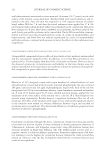J. Cosmet. Sci., 72, 215–228 (March/April 2021) 215 Dermal Effects of Unsaponifi able Compounds: The Overlooked Perspective of Vegetable Butters and Oils NINA POLJŠAK and NINA KOČEVAR GLAVAČ, Un iversity of Ljubljana, Faculty of Pharmacy, Ljubljana 1000, Slovenia (N .P., N.K.G.) Accepted for publication November 7, 2020. Sy n opsis Un saponifi able compounds are an integral part of vegetable butters and oils. Their composition is typically complex, and includes terpenic and aliphatic compounds, waxes, tocopherols and tocotrienols, phospholipids, and phenolic compounds. In this article, in vitro and in vivo studies of the dermal effects of unsaponifi able com- pounds from avocado (Persea americana), canola (Brassica sp.), coffee (Coffea arabica), hazel- nut (Corylus avellana), palm (Elaeis sp.), and soya (Glycine max) oils perilla (Perilla frutescens) seed meal and shea (Vitellaria paradoxa) butter were reviewed. Un saponifi able compounds as cosmetically and therapeutically active ingredients were proven to act as antioxidative, anti-infl ammatory, antitumor, immunomodulatory, and antimicrobial agents. They express wound healing, anti-acne, and anti-dermatitis activi- ties, as well as hydrating, photoprotective, and anti-wrinkle activities. It is thus also reasonable to recommend the use of unrefi ned vegetable butters and oils. Ho wever, no systematic studies regarding the dermal use of unsaponifi able compounds have been performed yet, and in-depth clinical research should be encouraged because of their promising dermal activity. VE GETABLE BUTTERS AND OILS Ve getable butters and oils are widely used in the pharmaceutical and cosmetic industries as extraction solvents, active ingredients, ingredients of the lipid phase in dermal formu- lations, and other excipients. Chemically they are a mixture of esters of glycerol and fatty acids (triglycerides), and unsaponifi able compounds (1). In general, the dermal effects of vegetable butters and oils include hydrating, emollient, antimicrobial, antioxidative, and anti-infl ammatory activities (2). Although the triglyceride fraction has been subject to Address all correspondence to Nina Poljšak at nina.poljsak@ffa.uni-lj.si.
JOURNAL OF COSMETIC SCIENCE 216 more research, signifi cantly less scientifi c work has been performed on unsaponifi able compounds. The focus of this article is on unsaponifi able compounds of vegetable butters and oils, and their action on the skin after dermal application. UN SAPONIFIABLE COMPOUNDS By defi nition, unsaponifi able compounds are components of vegetable butters and oils that are not saponifi ed when treated with alkali such as NaOH and KOH, but are soluble in lipids (3,4). They are typically extracted using organic solvents such as acetone, ether, heptane, hexane, and petroleum ether, and are not volatile at 103°C (4,5). The content of unsaponifi able compounds in vegetable butters and oils usually varies between 0.3 and 2% (6). Composition is complex and includes terpenic and aliphatic compounds, waxes, tocopherols and tocotrienols, phospholipids, and phenolic compounds (1,3), which are reviewed in the sections of this article that follow. Specifi c chemical families such as al- kylfurans, alkylphenols, alkenylphenols, ferulic acid derivatives, lignans, limonoids, and polyprenols are exceptional (3). The content and composition of unsaponifi able compounds is usually specifi c to a vegeta- ble butter or oil, but varies depending on the geographical origin, climatic and agro- nomic conditions, the quality of plant material for extraction, the extraction method, and exposure to refi ning. Changes in composition may also occur during the storage of a but- ter or oil, and are mainly due to hydrolysis and oxidation, that is, exposure to air (oxygen and humidity), temperature, and microbial contamination. The identifi cation of unsa- ponifi able compounds is thus particularly essential for the evaluation of a butter’s or oil’s quality, including possible falsifi cation. Analytical methods typically used are TLC, HPLC, GC-MS/FID, LC-GC, and SFC (7,8). DER MAL EFFECTS Sou nd scientifi c evidence about the benefi cial effects or effectiveness of dermally applied unsaponifi able compounds in cosmetic and pharmaceutical products is completely lack- ing because, to the best of our knowledge, there have been no in-depth, systematic stud- ies performed in this area to date. A d etailed search of scientifi c databases and books was performed for the purpose of this review article. Butters and oils presented in the section on “Unsaponifi able compounds in vegetable butters and oils” were included in Table 1 together with the composition of unsaponifi able compounds. It should be noted that the content of total and individual unsaponifi able compounds is based on the results of different scientifi c sources listed in the reference section and may vary in different studies. This mainly depends on the geo- graphic origin of a butter or oil, and the extraction procedure. DER MAL EFFECTS OF ISOLATED UNSAPONIFIABLE COMPOUNDS The following section provides a detailed review of the skin or skin-related effects of iso- lated unsaponifi able compounds grouped according to their general chemical structures (Figure 1).
Purchased for the exclusive use of nofirst nolast (unknown) From: SCC Media Library & Resource Center (library.scconline.org)

























































































































